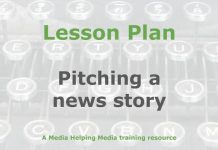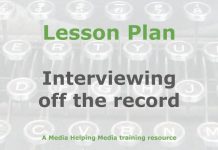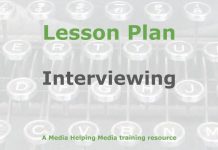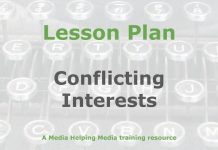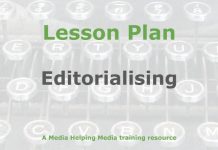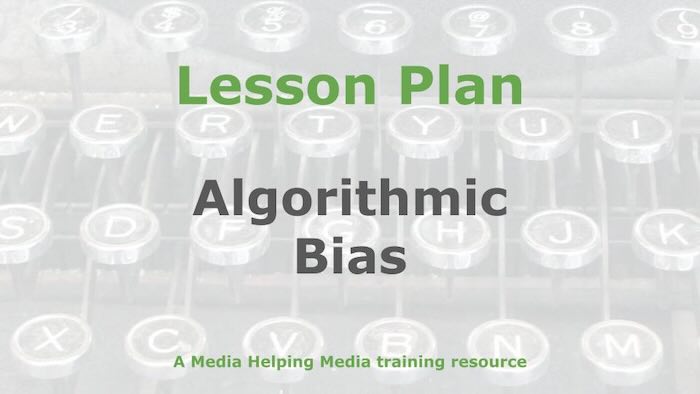 This lesson plan is designed to help journalists recognise and deal with algorithmic bias in the news production process.
This lesson plan is designed to help journalists recognise and deal with algorithmic bias in the news production process.
It is based on the article ‘Dealing with algorithmic bias in news‘, which we recommend trainers read before adapting this outline for your own purposes.
Learning objective
Students will identify and analyse instances of algorithmic bias in news content. They will evaluate the impact of such biases on news quality and credibility, using real-world case studies.
- Student-facing objective: By the end of this lesson the student will be able to spot and assess algorithmic bias in news stories and understand how it affects the news we read and produce.
- Standards: Journalist will learn how to spot and deal with algorithmic bias in news
Learning activities
Warm-up
Display a short news headline generated by an algorithm. Ask students: “What do you notice? What do you wonder?” Give them a few minutes to think and discuss with a partner. Then, select a few students to share their observations and questions. Record these for all to see. Guide the conversation towards recognising potential biases in the headline, such as language choice or topic emphasis. This primes students for deeper exploration of algorithm bias in news.
Direct instruction
- Introduction to algorithmic bias: Explain the concept of algorithmic bias. Define key terms: selection bias, confirmation bias, and representation bias. Use a real example, such as a news recommendation engine that consistently suggests similar types of stories, to illustrate how bias can manifest. Discuss the impact of these biases on news quality and credibility.
- Sources of algorithmic bias: Describe the origins of algorithmic bias. Highlight three main sources: biased data, biased algorithms, and lack of transparency. Provide a case study, such as the Facebook Cambridge Analytica scandal, to demonstrate how biased data can lead to skewed news coverage. Encourage students to consider how transparency in algorithm design could mitigate these issues.
- Case studies and lessons learned: Present a case study where algorithm bias affected news coverage, such as the YouTube algorithm’s role in spreading misinformation. Discuss the lessons learned from this case. Ask students to identify signs of bias and suggest strategies for reducing its impact. Emphasise the importance of human oversight and editorial judgement in balancing algorithmic recommendations with journalistic integrity.
Guided practice
Think, Pair, Share: Guide students through a structured discussion to identify algorithmic bias in news content.
- Think: Present a news article generated by an algorithm. Ask students to individually identify potential biases, focusing on language, source selection, and representation.
- Pair: Have students pair up to discuss their findings. Encourage them to compare observations and refine their understanding of algorithmic bias.
- Share: Facilitate a class discussion where pairs share their insights. Record key points on the board, highlighting common biases and unique observations.
- Connect: Relate the discussion back to the case studies covered in direct instruction. Ask students to connect their findings with real-world examples.
- Reflect: Conclude with a reflection on how recognising algorithmic bias can improve news quality and credibility. Encourage students to consider the role of journalists in mitigating bias.
Independent practice
- Bias detection exercise: Provide students with a set of news articles generated by algorithms. Instruct them to identify and annotate instances of potential bias, focusing on language, source selection, and representation. Use a digital tool or printed copies for annotations.
- Analysis and reflection: Ask students to write a brief analysis of their findings, discussing the impact of identified biases on news quality and credibility. Encourage them to propose strategies for mitigating these biases.
- Peer review: Pair students to exchange their analyses. Have them provide constructive feedback on each other’s work, focusing on the clarity of bias identification and the feasibility of proposed strategies.
Assignment
Ask students:
- What is one example of algorithmic bias you identified in today’s lesson?
- How can journalists help mitigate algorithmic bias in news content?
- What’s one question you still have from today’s lesson?
Suggested answers:
- Suggested answer to Question 1: An example is the YouTube algorithm promoting misinformation by favouring sensational content.
- Suggested answer to Question 2: Journalists can advocate for transparency in algorithm design and apply human oversight to ensure balanced news coverage.
Teacher resources
Differentiation guide
- Advanced learners: Encourage deeper analysis by having them explore additional case studies or research articles on algorithmic bias. Challenge them to propose innovative solutions for mitigating bias, considering ethical implications and technological advancements.
- Striving learners: Simplify concepts by using more relatable examples and providing additional scaffolding, such as graphic organisers or guided notes. Offer more structured support during activities, such as pairing them with peers who can assist in discussions and exercises.
- Recommended reading: This lesson plan is based on the article ‘Dealing with algorithmic bias in news‘, which we recommend trainers read before adapting this outline for your own purposes.
Notable definitions
Algorithmic bias: The systematic and repeatable errors in a computer system that create unfair outcomes, such as privileging one arbitrary group of users over others.
Selection bias: A type of bias caused by selecting non-random data for analysis, which can lead to inaccurate conclusions.
Confirmation bias: The tendency to favour information that confirms existing beliefs or hypotheses, often leading to skewed data interpretation.
Required materials
- Computers: For accessing digital news articles and annotation tools.
- Printed copies: News articles for annotation exercises (optional).
- Digital annotation tools: Software or apps for marking up digital articles.
- Whiteboard/Markers: For recording observations and discussion points.
- Projector: To display news headlines and case studies.
- Notebooks/Pens: For students to take notes and write reflections.
Lesson summary
- Warm-up
- Direct instruction
- Guided practice
- Independent practice
- Assignment
The free teaching tools at the Khan Academy were used in the production of this lesson plan.

